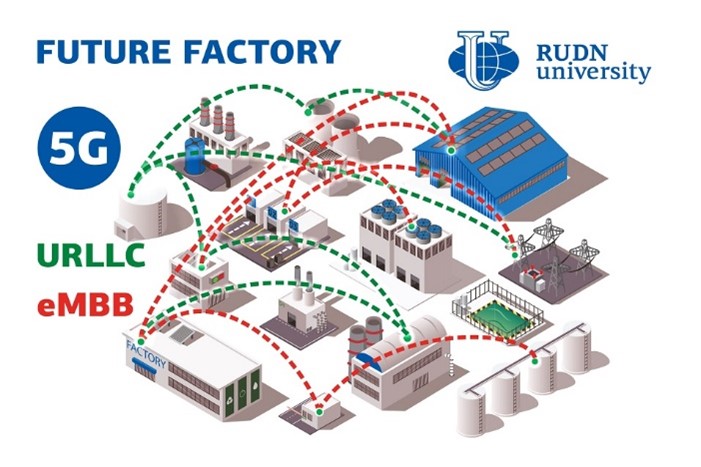RUDN mathematicians have calculated how to make 5G communications at the factory of the future

5G technology, or New Radio (NR), implies simultaneous support for two services — eMBB (enhanced Mobile BroadBand) mobile broadband access and a highly reliable connection with low latency URLLC (Ultra-Reliable and Low-Latency Communication). The eMBB service is a regular mobile Internet, the next stage of development of mobile data networks after 4G. URLLC is designed for remote control of mechanisms and robots — for example, unmanned vehicles. In real conditions, eMBB and URLLC traffic are mixed, which can reduce the speed and reliability of the connection. RUDN mathematicians suggested how to solve this problem. To do this, the main thing is to calculate the correct strategy for prioritizing services within the network.
“Fifth generation (5G) mobile systems have been developed for a wide range of applications. Therefore, NR base stations must support both eMBB and URLLC. Research is now focusing on mechanisms to support these services in isolation. However, the joint support of these types of traffic has received little research. We investigated the possibility of simultaneous support of eMBB and URLLC in industrial 5G NR networks using prioritization,” Daria Ivanova, graduate student of the Department of Applied Informatics and Probability Theory of the RUDN University.
RUDN mathematicians examined a model of the plant of the future. It is assumed that the 5G network is deployed in some production facility equipped with mobile robots and a variety of devices, sensors and detectors. They transmit data to the cloud service, where the control module makes decisions and gives new tasks. Sensors and sensors generate URLLC traffic, and monitoring devices generate eMBB traffic. This causes everything in the plant to move, interfering with the signal. Having described this system mathematically, scientists have selected an optimal network strategy that provides better speed and reliability with a minimum number of base stations.
It turned out that with the help of prioritization it is possible to completely “separate” eMBB and URLLC traffic from each other. The D2D (device-to-device) strategy allows you to achieve the most reliable connection, namely, to ensure that the probability of URLLC interruption is only one thousandth of a percent. The secret of D2D is that the base station deliberately reserves some resources for the direct exchange of information between the devices themselves.
“Our numerical results show that prioritization can effectively isolate traffic and does not require external control. A D2D-oriented strategy, where the base station reserves some resources for direct communication, is significantly superior to those where no explicit reservation is used, as well as a strategy where all traffic passes through the base station. Our model can be used to calculate the required density of base stations for all considered strategies,” Ekaterina Markova, Candidate of Physical and Mathematical Sciences, Associate Professor of the Department of Applied Informatics and Probability Theory of the RUDN University.
The results were published in the IEEE Access journal.
RUDN summarized the results of the scientific competition "Project Start: work of the science club ". Students of the Faculty of Physics, Mathematics and Natural Sciences have created a project for a managed queuing system using a neural network to redistribute resources between 5G segments. How to increase flexibility, make the network fast and inexpensive and reach more users — tell Gebrial Ibram Esam Zekri ("Fundamental Computer Science and Information Technology", Master's degree, II course) and Ksenia Leontieva ("Applied Mathematics and Computer Science", Master's degree, I course).
The National Demographic Report, 2023 Demographic Well-Being of Russian Regions (hereinafter - the National Demographic Report) was prepared by the scientific team of the Institute of Demographic Studies of the Federal Research Center of the Russian Academy of Sciences, the Vologda Scientific Center of the Russian Academy of Sciences, Peoples' Friendship University of Russia, the Center for Family and Demography of the Academy of Sciences of the Republic of Tatarstan, as well as with the participation of leading scientists from the Republic of Bashkortostan, Stavropol Krai, Volgograd, Ivanovo, Kaliningrad, Nizhny Novgorod, Sverdlovsk Oblasts and Khanty-Mansi Autonomous Okrug–Yugra.
RUDN summarized the results of the scientific competition "Project Start: work of the science club ". Students of the Faculty of Physics, Mathematics and Natural Sciences have created a project for a managed queuing system using a neural network to redistribute resources between 5G segments. How to increase flexibility, make the network fast and inexpensive and reach more users — tell Gebrial Ibram Esam Zekri ("Fundamental Computer Science and Information Technology", Master's degree, II course) and Ksenia Leontieva ("Applied Mathematics and Computer Science", Master's degree, I course).
What is your first association with the word “laboratory”? Flasks and beakers? Microscopes and centrifuges? Yes, many of us would answer the same way.
The National Demographic Report, 2023 Demographic Well-Being of Russian Regions (hereinafter - the National Demographic Report) was prepared by the scientific team of the Institute of Demographic Studies of the Federal Research Center of the Russian Academy of Sciences, the Vologda Scientific Center of the Russian Academy of Sciences, Peoples' Friendship University of Russia, the Center for Family and Demography of the Academy of Sciences of the Republic of Tatarstan, as well as with the participation of leading scientists from the Republic of Bashkortostan, Stavropol Krai, Volgograd, Ivanovo, Kaliningrad, Nizhny Novgorod, Sverdlovsk Oblasts and Khanty-Mansi Autonomous Okrug–Yugra.